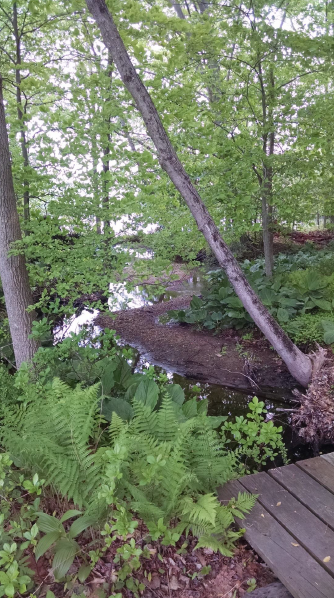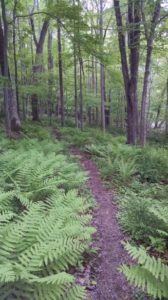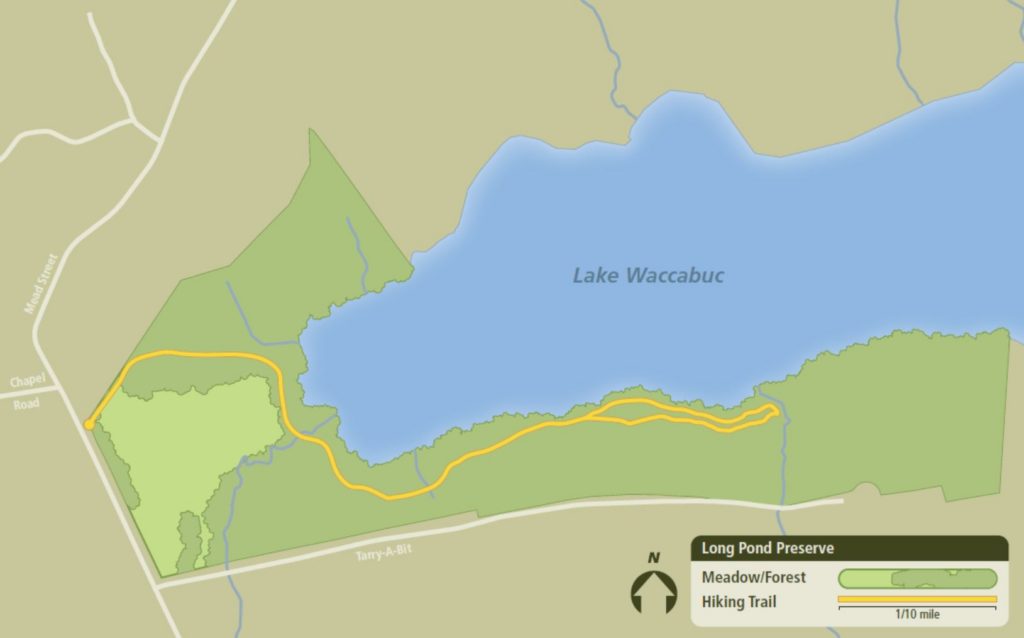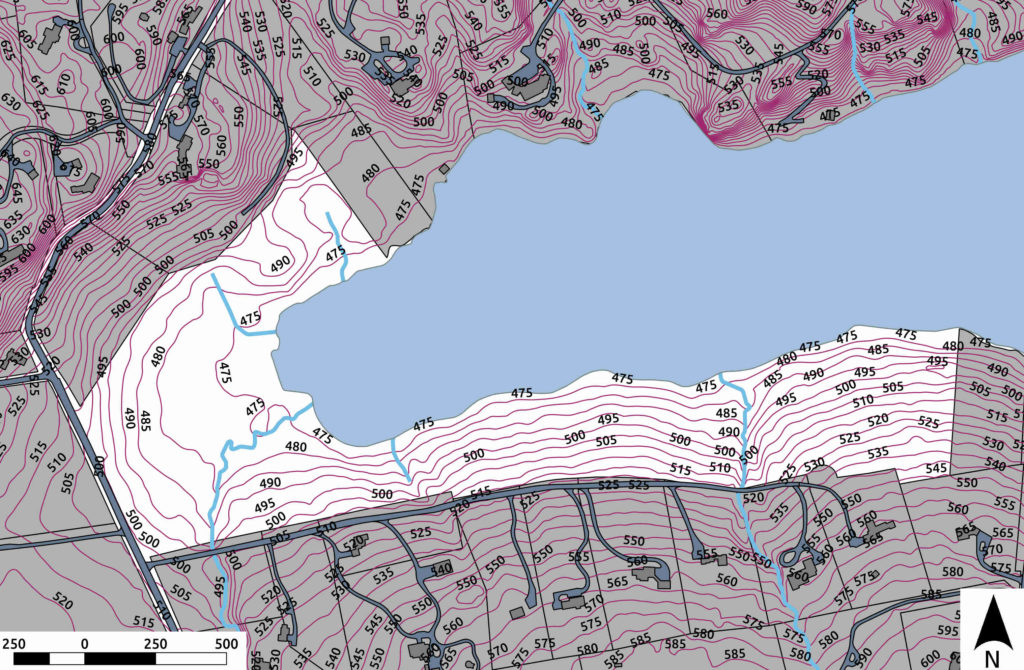Long Pond Preserve
Long Pond Preserve consists of approximately 37 acres of wet meadow and upland forest. Mead Street, Tarry-a-bit, Lake Waccabuc, and private properties form the borders to the preserve. Lake Waccabuc was once known as Long Pond, hence the preserve name. The Preserve includes a seven-acre wet meadow along the Mead Road frontage which overlooks the west end of the lake. Most of the Preserve is forest. Old stone walls run along the Mead Road frontage and portions of the northern and southern boundaries. A storm water retention basin, constructed by the Town of Lewisboro, sits on the west side of the meadow. It retains phosphorus, silt, and other pollutants which otherwise would enter the lake.
Long Pond Preserve has forest and meadow habitats typical of northern Westchester County. The meadow, forest, and lake environs support a variety of plant and animal species. Waccabuc Creek enters the Preserve at the southwest corner of the property and flows into the lake within the Preserve shoreline. This creek carries water from the Waccabuc Country Club golf course and under Tarry–a-bit and has deposited a sand bar at the west end of Lake Waccabuc. Smaller, sometimes intermittent streams also flow across the preserve from the north and south. Wetlands extend back from the lake shore along the stream corridor and northwest towards the preserve entrance. Skunk cabbage is prevalent in the wetlands, along with invasive phragmites.
The meadow allows a splendid view of the lake. Periodic mowing supports the meadow, keeps out many shrubby plants, and maintains many species which would perish if succession were permitted to proceed. The field is a source of aesthetic pleasure to all who view its continually changing colors as different species reach their peak of bloom and dominate the landscape. Keep an eye out for the many birds and pollinators that visit during the year.
Forested areas are dominated by mature hardwoods with beech, maple and oak being the most common species. Mature hemlocks occupy portions of the forest community above the southern shoreline. Common native understory plant species include witch hazel, spicebush, and viburnums. Heavy browsing by white-tailed deer limits the density of the undergrowth. Invasives, particularly barberry, are widespread in the woodland area of the property. A reforestation project area shelters the stream shoreline and the edge of the meadow. Tree saplings in protective tree tubes were planted in the meadow along the banks of the creek as part of the NYSDEC Trees for Tribs program. Maintenance of these trees each spring and fall is performed with the assistance of the Watershed Agricultural Council (WAC). Under the direction of WAC, volunteers also installed willow stakes along the creek to assist with stream bed stabilization.
Preserve trail
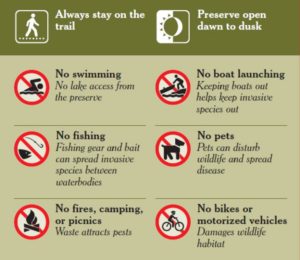 A half-mile trail provides walking access through Long Pond Preserve and runs parallel to the southern lake shore. An entrance sign at the trail head opposite the intersection of Mead Street and Chapel Road contains preserve information. The preserve is open dawn to dusk. Several small bridges have been built where the trail crosses small streams and wet areas as the path nears the lake. Some old iron machinery is near the loop portion of the trail; these are remnants of a 19th century ice house previously active on the property. A boathouse and a water pumping station once occupied portions of the preserve but there is little evidence of those structures today. A few telephone poles remain at the west end of the lake.
A half-mile trail provides walking access through Long Pond Preserve and runs parallel to the southern lake shore. An entrance sign at the trail head opposite the intersection of Mead Street and Chapel Road contains preserve information. The preserve is open dawn to dusk. Several small bridges have been built where the trail crosses small streams and wet areas as the path nears the lake. Some old iron machinery is near the loop portion of the trail; these are remnants of a 19th century ice house previously active on the property. A boathouse and a water pumping station once occupied portions of the preserve but there is little evidence of those structures today. A few telephone poles remain at the west end of the lake.
Preserve history
The preserve land, together with Castle Rock, was donated to The Nature Conservancy (TNC) in 1970. The Castle Rock parcel was separated and sold in 1981 and Castle Rock is now private property. Also note that Tarry-a-bit is a private road. In November 2015 the Nature Conservancy transferred the property to the Three Lakes Council. It came with restrictions, protections, and easements, including the requirement that the land continue as a nature preserve. We gratefully recognize TNC’s role in protecting this preserve.
Guidelines
Three Lakes Council continues to manage the property in much the same way that it was managed under TNC ownership. While the preserve is open for walking and observing nature, no lake access is allowed. No swimming, fishing boat launching, or boat storage is allowed. Boats, floats, and fishing gear can transfer invasive species from one lake to another. The New York laws that encourage owners to allow access to visitors do not encompass swimming. No picnicking is allowed because no sanitary facilities are on the property. Please carry out all that you carry in. Because this nature preserve has unique habitat for birds and ground animals, we discourage the presence of pets that might disturb them, especially during migration and nesting periods.
A wetland basin is part of a stormwater retrofit project on the preserve near Mead Street. The basin was planted with a variety of wetland and meadow plants. The purpose of the project is to collect, convey, and treat polluted runoff from a drainage area of approximately 25 acres. This reduces sediment and phosphorous pollution entering the lake. This project removes an estimated 3.5 kg of phosphorus load from the lake each year. The was project was funded through a grant from the New York City Department of Environmental Protection (NYCDEP) as part of a regional program to protect the NYC Watershed drinking supply system.
From the initial open space preservation actions in 1969 through the ongoing activities today, Long Pond Preserve has conserved open space, provided a variety of wildlife and wetland habitats, and has protected the water quality of Lake Waccabuc. We are pleased to be entrusted to continue the stewardship of this property.
One of our many tasks is to develop a new management plan for Long Pond Preserve to help us prioritize our activities at the preserve. The current 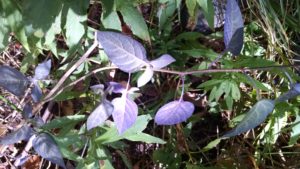 plan, written in 1981 for The Nature Conservancy, can be found here. Dr. Cooney compiled a list of plants spotted between 2001 and 2003. In 2017, we began releasing mile-a-minute weevils to help control the invasive terrestrial plant mile-a-minute. We cut back stands of invasive phragmites, and found and pulled a stand of beautiful but invasive bittersweet nightshade. The preserve is filled with invasive plants so this will be a long-term endeavor.
plan, written in 1981 for The Nature Conservancy, can be found here. Dr. Cooney compiled a list of plants spotted between 2001 and 2003. In 2017, we began releasing mile-a-minute weevils to help control the invasive terrestrial plant mile-a-minute. We cut back stands of invasive phragmites, and found and pulled a stand of beautiful but invasive bittersweet nightshade. The preserve is filled with invasive plants so this will be a long-term endeavor.
